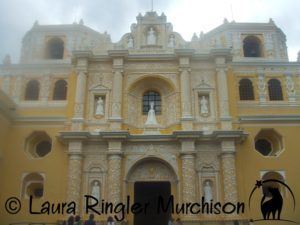Our third day we explored Antigua. I really had no idea what to expect. But I felt safe and we encountered genuinely smiling faces wherever we went. Antigua is the capital of the Sacatepequez Province of Guatemala, famous for its well-preserved Spanish Baroque influenced architecture. For over two centuries it was the political, religious, and economic center for Spain in Central America before being abandoned due to numerous earthquakes. The first photo I took is pictured here of the Church and convent of Nuestra Señora de la Merced. The Mercedarian order was established in Guatemala in 1538. However, what you see was rebuilt in 1717 after an earthquake. The facade is perhaps the most beautiful in Antigua, featuring intricate, ornate patterns in white stucco on a yellow background. This church serves as a good example of “earthquake baroque” architectural style popular by necessity in Central America. Note the short bell towers as opposed to the soaring ones built in seismically less active Mexico during the same epoch. Antigua has been regularly rocked due to being surrounded by three volcanoes: Agua, Fuego, and Acatenango. The aptly named Fuego (fire) is still active and we even got to see small ash clouds spewing from its mouth as we walked along the town. We stood inside the gloomy but very impressive ruins of the giant nave of the Catedral, completed in 1680; another victim of one of Antigua’s many great earthquakes, this one in 1773. It was an unusual experience to be surrounded by four walls but left totally bare to the open sky. I had the feeling of ephemeral safety. Then it struck me that “antiqua” means “antique” or “old” and I thought how fitting it was given the city seemed to be frozen in time. And not just the city; I believe the ancient Mayan culture of the people, smiling without malice, could not be driven out, coerced out, beaten out or erased from these people. How I wish the same were true for other Native Peoples, particularly in North America. Indian born neuroscientist Vilayanur S. Ramachandran said this:
“Remember that politics, colonialism, imperialism and war also originate in the human brain.”
From what I witnessed, the ancient Mayans’ strength and resilience against the mighty powers of colonialism is truly impressive and continues to this day. Mother Earth may have had her hand in it as well, but then Native Peoples have always needed all the help they could possibly get. Achukma hoke.

